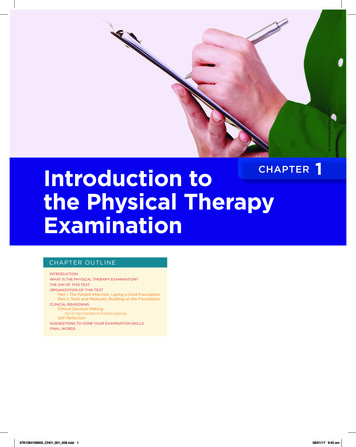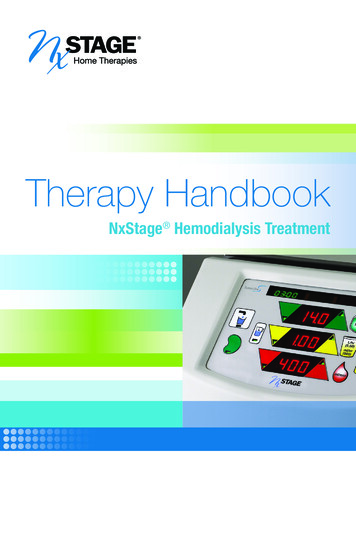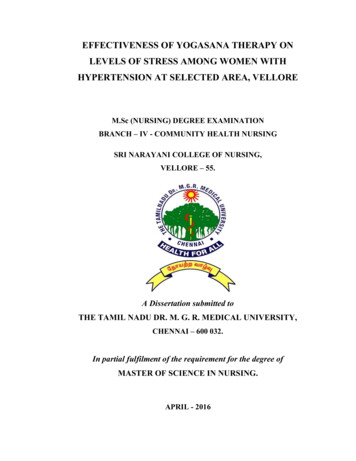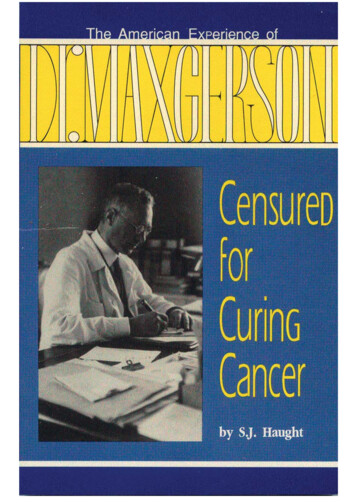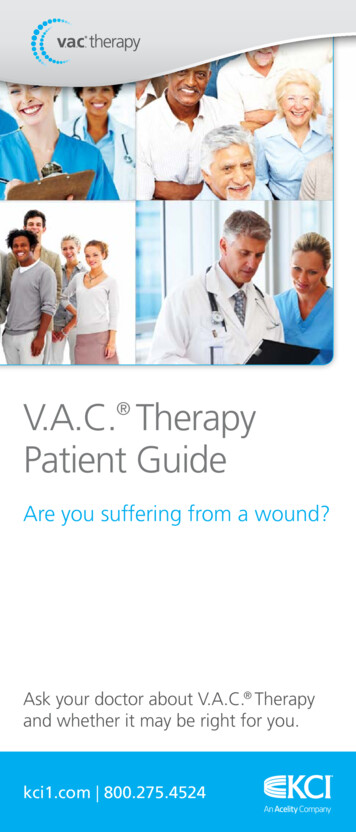
Transcription
V.A.C. TherapyPatient GuideAre you suffering from a wound?Ask your doctor about V.A.C. Therapyand whether it may be right for you.kci1.com 800.275.4524
Table of ContentsWound Healing is a Process . . . . . . . . . . . . . . . . 2How Long Will it Take to Heal My Wound? . . . . . 2What is V.A.C. Therapy? . . . . . . . . . . . . . . . . . . 2Four Part Advanced Wound Therapy System . . . . 3There is Only One V.A.C. Therapy . . . . . . . . . . . 4V.A.C. Dressing Placement . . . . . . . . . . . . . . . . . 4V.A.C. Dressing Changes . . . . . . . . . . . . . . . . . . 5Frequently Asked Questions aboutV.A.C. Therapy . . . . . . . . . . . . . . . . . . . . . . . . . 6
Wound Healing is a ProcessProper wound care management is important toheal your wound and your doctor may prescribethe V.A.C. Therapy System for your care. A clinicianis responsible for directing the use of the V.A.C. Therapy System including application and periodicdressing changes.How Long Will it Take to Heal MyWound?The length of time to heal a wound is different forevery patient. General conditions, size and locationof the wound, and nutritional status can affect thetime it takes for a wound to heal. Your clinician willdiscuss when and why V.A.C. Therapy may beginand end.What is V.A.C. Therapy?V.A.C. Therapy is a medical device system thatpromotes wound healing by delivering negativepressure (a vacuum) to the wound through apatented dressing and therapy unit creating anenvironment that promotes the wound healingprocess. This negative pressure helps draw woundedges together, remove wound fluids and infectiousmaterials and promote granulation tissue formation(the connective tissue in healing wounds).Unlike gauze bandages that merely cover a wound,V.A.C. Therapy actively works to help the woundhealing process.The V.A.C. Therapy System helps: Promote wound healing Provide a moist wound healing environment Draw wound edges together Remove fluid and infectious materials Reduce wound odor Reduce the need for daily dressing changes2
The V.A.C. Therapy System is anAdvanced Wound Therapy SystemConsisting of Four Parts: The V.A.C. Therapy unit that delivers negativepressure Sterile plastic tubing with SensaT.R.A.C. pressuresensing lumens that connect the therapy unit tothe dressing Special foam dressings (V.A.C. GranuFoam andV.A.C. WhiteFoam Dressings) that are placed inthe wound A clear drape with adhesive (V.A.C. Drape) thatcovers the foam dressing(s)Device illustration representative only.Your doctor may prescribe a differentV.A.C. Therapy unit.V.A.C. Therapy tubingV.A.C. DrapeV.A.C. GranuFoam Dressing3
There is Only One V.A.C. TherapyKCI commercialized the world’s first negativepressure wound therapy (NPWT) system, V.A.C. Therapy, and is a market leader in advancedwound therapy.With more published clinical evidence than anyother form of NPWT, V.A.C. Therapy has beenselected as the treatment of choice for more than8 million wounds worldwide. Many clinicians,hospitals, skilled nursing facilities, wound carecenters and home health agencies use or prescribethe advanced V.A.C. Therapy System to help theirpatients heal.There are other NPWT systems, but utilizing aproprietary NPWT pump, advanced software andpressure regulating technology (SensaT.R.A.C. )and a diverse foam dressing portfolio, V.A.C. Therapy is the original and most widely prescribedNPWT treatment in the world.V.A.C. Dressing PlacementThe V.A.C. Dressing goes on or inside a wound.One end of the tubing connects to the dressing.The other end connects to the canister that fitsinto the therapy unit. The wound area is sealedwith the clear V.A.C. Drape with adhesive thathelps maintain negative pressure over the wound.SensaT.R.A.C. PadV.A.C. GranuFoam Dressing**If used, the V.A.C. WhiteFoam Dressing is typicallyrecommended for placement under the V.A.C. GranuFoam Dressing.4
V.A.C. Dressing ChangesThe V.A.C. Therapy System uses proprietary foamdressings (V.A.C. GranuFoam and/or WhiteFoam)with the therapy unit. Only V.A.C. Dressings are tobe used with the V.A.C. Therapy Units. Woundstreated with the V.A.C. Therapy System should bemonitored on a regular basis by your clinicians whoare responsible for treatment. For a non-infected wound: KCI recommends theV.A.C. Dressings be changed every 48 to 72hours, but no less than 3 times per week. For infected wounds: These wounds must bemonitored often and very closely. Infectedwounds dressing changes may need to bechanged more often than 48 to 72 hours.Dressing change intervals should be based oncontinuing evaluation of your wound conditionby your clinician.IMPORTANT: The V.A.C. Therapy System isindicated for patients with chronic, acute, traumaticand dehisced wounds, partial-thickness burns, ulcers(such as diabetic, venous leg, or pressure), and flapsand grafts. When used on closed surgical incisions,V.A.C. Therapy is intended to manage the environment of surgical incisions that continue to drainfollowing sutured or stapled closure by maintaininga closed environment and removing exudates viathe application of negative pressure wound therapy.V.A.C. Therapy is contraindicated for patients withmalignancy in the wound, untreated osteomyelitis,non-enteric and unexplored fistulas, necrotic tissuewith eschar present and sensitivity to silver (V.A.C.GranuFoam Silver Dressing only).Do not place V.A.C. Foam Dressings in contactwith exposed blood vessels, anastomotic sites,organs, nerves. Please discuss and review thisinformation and the device instructions for usewith your clinician so you can fully understand thebenefits and risks of V.A.C. Therapy.5
Some frequently asked questionsabout V.A.C. Therapy1. How does V.A.C. Therapy feel?Most patients describe V.A.C. Therapy as a nonpainful, mild pulling sensation that, in most cases, isnot noticeable after a few minutes. Wound comfortmay vary by individual. The wound may becometender or itch as it heals; this is usually a good sign.If itching or discomfort persists, please contact yourdoctor.2. Can you move around while on V.A.C. Therapy?Your ability to move around depends on yourcondition, the wound location and type of therapyunit prescribed. The V.A.C. Therapy System maybe disconnected so you can take a shower. Therapymay not be off any longer than two hours per day.3. What does the foam dressing look like whenV.A.C. Therapy is working?Your doctor may prescribe a V.A.C. GranuFoam or V.A.C. WhiteFoam Dressing for your woundtype. The V.A.C. GranuFoam Dressing willshrink down and wrinkle like a raisin when V.A.C. Therapy is working. The V.A.C. WhiteFoamDressing may only have a few wrinkles.4. Does changing the V.A.C. Dressing hurt?Some people do experience discomfort duringdressing changes depending on the wound type,location and patient condition. The discomfort issimilar to other dressings and wound care treatmentsfor the same wound type. Your doctor or nurse cangive you advice about pain relief.6
5. Who should change my dressing?Usually a nurse from your doctor’s office, homehealth agency or wound care clinic trained inV.A.C. Therapy, will change your dressing. If deemedappropriate by your doctor or nurse, a caregiver,family member or friend may change the dressingif they have been properly trained. To help stop thespread of germs and infection, cover your mouth andnose with a tissue when you cough or sneeze andput your used tissue in a waste basket, or cough orsneeze into your upper sleeve, not your hands. Thefollowing steps should be followed by you and/oryour caregiver to reduce the risk of infection: Caregiver should wash hands with soap andwarm water for 20 seconds or clean hands withan alcohol-based hand cleaner, before and aftereach patient contact or procedure. Caregiver should always wear gloves andprotective clothing and eyewear when handlingblood or body fluid, or when in contact withmucous membranes or open cuts. Any caregiver with an open cut or skin conditionshould not care for the patient until the conditionhas been cleared. Caregiver should dispose of soiled dressingaccording to hospital or institution protocols. Donot reuse dressing. Caregiver should always note the total numberof pieces of foam used in the wound anddocument on the Foam Quantity Label (if supplied)and in the patient’s chart. Refer to application instructions provided withthe dressing.7
6. When should I call my clinician when onV.A.C. Therapy?Immediately report to your clinician if you have anyof these symptoms: Fever over 102 DiarrheaHeadacheSore throatConfusionSick to your stomach or throwing upDizziness or feel faint when you stand upRedness around the woundSkin itches or rash presentWound is sore, red or swollenPus or bad smell from the woundArea in or around wound feels very warm7.What happens if the V.A.C. Therapy System alarms?The V.A.C. Therapy System is built with your safetyin mind. The V.A.C. Therapy unit has alarms thatyou can see and hear which will alert you to apotential problem. In most situations, the reasonfor the alarm is easily fixed. This is something yourclinician can explain in more detail, so you arecomfortable with this alarm system.8. How noisy is the V.A.C. Therapy System?All of the V.A.C. Therapy Systems are medicaldevices with moving parts. Noise may seem louderat night when surrounding noise level is greatlydecreased. The units are designed with softwarethat help to identify leaks at the wound site.When a leak is present, the unit may make aramping noise and the unit will begin to alarm.When the seal has been fixed, the unit will no longeralarm and the ramping noise will stop. The unit mayalso have a gurgling sound when clearing air fromthe system.8
9. Who should I contact if I have further questions?Contact your clinician with any medical questions.In case of an emergency immediately call your localemergency contact number (i.e. 911). Once V.A.C. Therapy is prescribed, for questions about V.A.C. Therapy System operation, call 1-800-275-4524.9
To learn more about the KCIV.A.C. Therapy System, please visitwww.kci1.com or call us at1-800-275-4524.This is a summary of some basic information about V.A.C. Therapy. It is notintended to be a guide to product use, operation and placement. Please readthe V.A.C. Therapy System Quick Reference Guide and V.A.C. Therapy SystemUser Manual for specific questions and important information about V.A.C. Therapy System indications, contraindications, warnings, precautions andoperation and discuss this information with your clinician.CAUTION: Federal law restricts this device to sale/rental by or on theorder of a physician. 2009 KCI Licensing, Inc. All rightsreserved. All trademarks designated hereinare proprietary to KCI Licensing, Inc., itsaffiliates and/or licensors.DSL#14-0389.US LIT#29-A-200 (Rev. 9/14)
The V.A.C. Dressing goes on or inside a wound. One end of the tubing connects to the dressing. The other end connects to the canister that fits into the therapy unit. The wound area is sealed with the clear V.A.C. Drape with adhesive that helps maintain negative pressure over the wou





